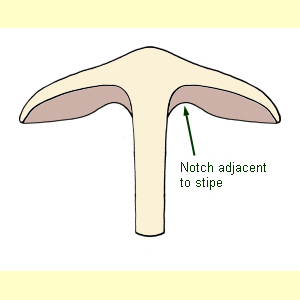
Lamellae attachment can be observed by turning over the fruit-body and looking at the points where the lamellae join the stipe. In addition, a longitudinal cross section of the fruit-body is useful to expose the lamellae and see the attachment side-on. Care is needed when making the cross section so as not to tear the lamellae away from the stipe, thus giving them the appearance of being free when, in fact, they are adnexed or adnate.
Lamellae attachment is best observed on mature fruit-bodies, where the pileus has expanded. On over-mature fruit-bodies, where the pileus begins to shrivel or turn upwards, the lamellae can pull away from the stipe. The presence of thin, longitudinal lines at the extreme apex of the stipe can be a sign that the lamellae have become detached.
If there is no stipe, or the stipe is rudimentary, do not enter any states for lamellae attachment.
Choose this state if: the lamellae have edges that are curved near the stipe. These curves resemble a side-on S-shape, but are not symmetrical. Thus, the edges initially ascend, but near the stipe there is a small descent. This state also includes lamellae described as 'notched', as if a small piece of each lamella near the stipe was removed.
